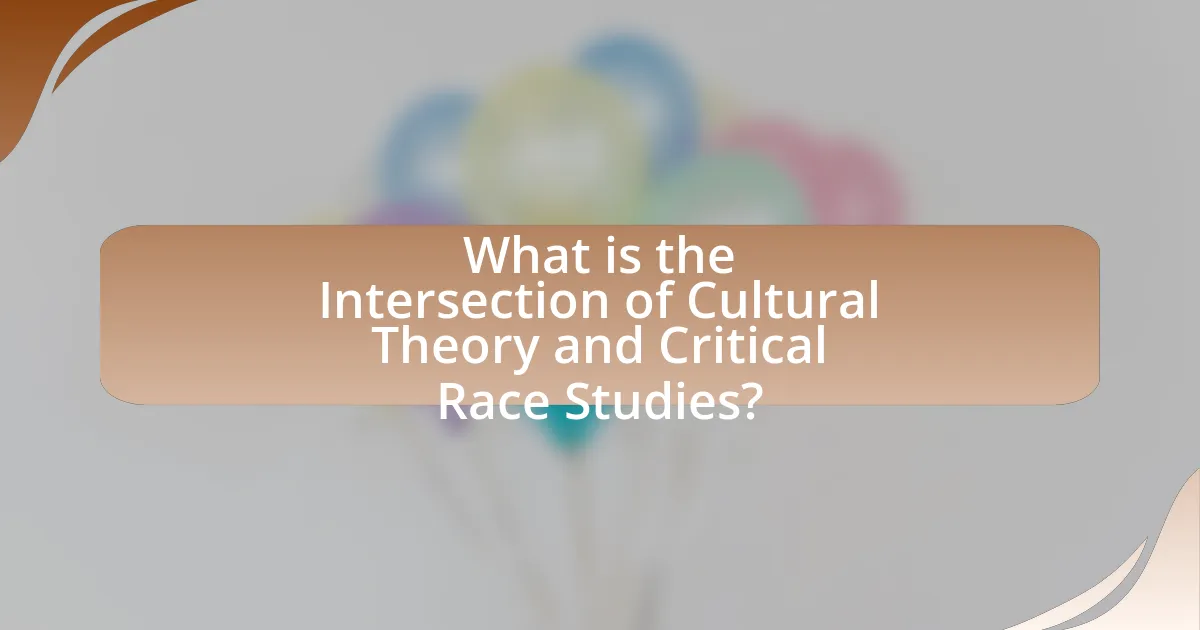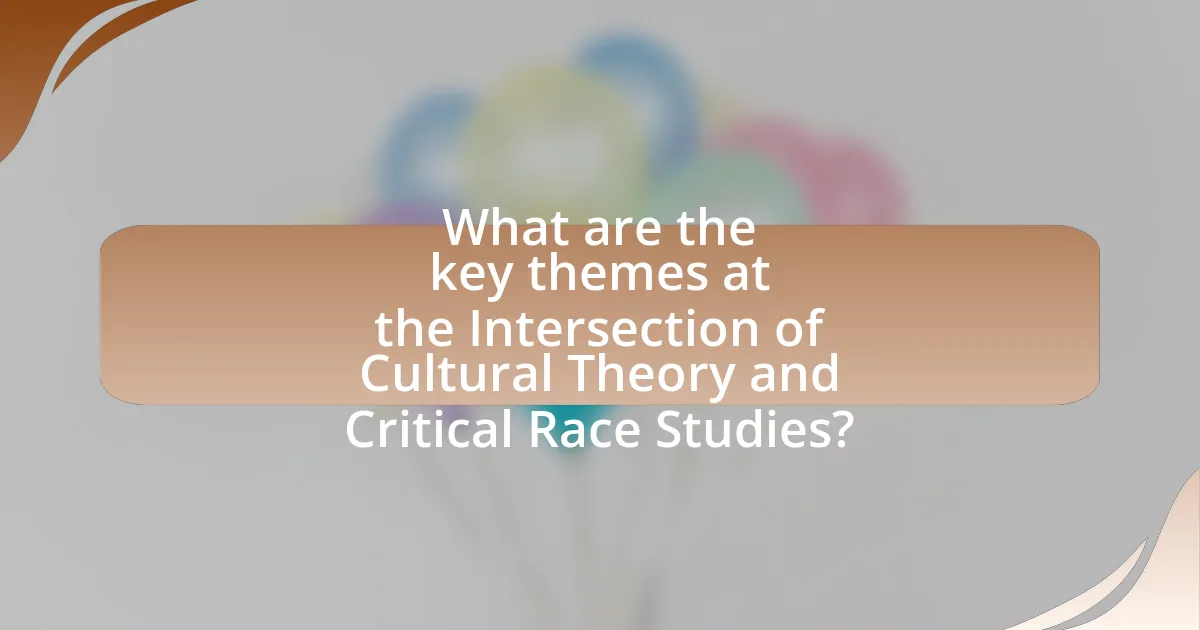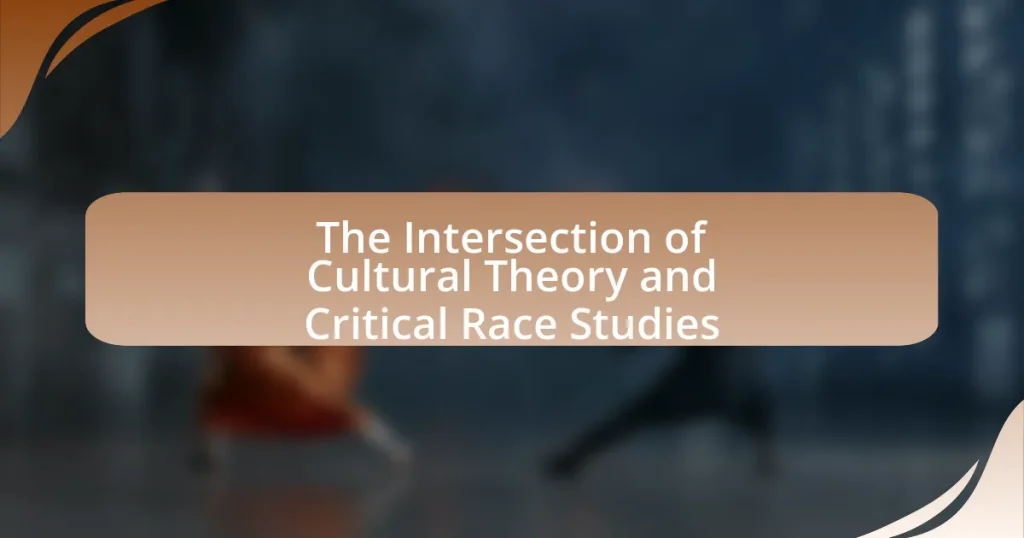The article explores the intersection of Cultural Theory and Critical Race Studies, focusing on how cultural practices and representations influence racial identities and power dynamics. It outlines foundational concepts of both fields, emphasizing the importance of representation, identity formation, and systemic racism. Key themes include the critique of dominant narratives and the role of intersectionality in understanding complex social dynamics. The article also discusses the implications for social justice movements, educational practices, and policy development, highlighting strategies to promote equity in cultural institutions and the challenges faced in integrating these disciplines.

What is the Intersection of Cultural Theory and Critical Race Studies?
The intersection of cultural theory and critical race studies examines how cultural practices and representations shape and are shaped by racial identities and power dynamics. Cultural theory provides frameworks for understanding the role of culture in social life, while critical race studies focus on the systemic nature of racism and its impact on marginalized communities. This intersection highlights the ways in which cultural narratives can perpetuate or challenge racial stereotypes and inequalities, as evidenced by scholars like Stuart Hall, who emphasized the importance of representation in understanding race, and bell hooks, who explored the intersections of race, gender, and culture.
How do Cultural Theory and Critical Race Studies relate to each other?
Cultural Theory and Critical Race Studies are interconnected through their shared focus on understanding power dynamics and social hierarchies. Cultural Theory examines how culture shapes societal norms and values, while Critical Race Studies specifically analyzes how race and racism influence these cultural constructs. Both fields critique dominant narratives and highlight marginalized voices, emphasizing the importance of context in shaping identity and experience. For instance, scholars like Stuart Hall in Cultural Theory and Kimberlé Crenshaw in Critical Race Studies have demonstrated how cultural representations can perpetuate racial stereotypes, thus illustrating the necessity of integrating insights from both disciplines to fully comprehend the complexities of identity and power in society.
What are the foundational concepts of Cultural Theory?
The foundational concepts of Cultural Theory include the ideas of cultural relativism, power dynamics, identity formation, and the role of ideology in shaping social practices. Cultural relativism posits that cultural norms and values are understood within their specific contexts, rejecting ethnocentrism. Power dynamics examine how cultural practices are influenced by social hierarchies and inequalities. Identity formation focuses on how individuals and groups construct their identities through cultural narratives and practices. Lastly, the role of ideology highlights how dominant cultural narratives shape perceptions and behaviors within society. These concepts are essential for analyzing cultural phenomena and their implications in various social contexts, particularly in relation to critical race studies, where they help unpack the complexities of race, identity, and power.
What are the key principles of Critical Race Studies?
The key principles of Critical Race Studies include the recognition that racism is ingrained in the fabric of society, the importance of experiential knowledge, and the commitment to social justice. Critical Race Studies asserts that racism is not merely an individual bias but a systemic issue that affects laws, policies, and institutions. This perspective emphasizes the significance of personal narratives and lived experiences of marginalized groups as valid sources of knowledge. Furthermore, the field advocates for the transformation of society through activism and policy change to address and dismantle racial inequalities. These principles are supported by the work of scholars such as Derrick Bell, who introduced the concept of interest convergence, and Kimberlé Crenshaw, who developed the theory of intersectionality, highlighting how various forms of discrimination overlap and impact individuals differently.
Why is the intersection important in contemporary discourse?
The intersection of cultural theory and critical race studies is important in contemporary discourse because it provides a framework for understanding how race and culture interact to shape social identities and power dynamics. This intersection allows for a nuanced analysis of systemic inequalities, highlighting how cultural narratives can perpetuate or challenge racial injustices. For instance, scholars like bell hooks and Stuart Hall have emphasized the significance of cultural representation in shaping public perceptions of race, demonstrating that cultural theory can illuminate the complexities of racial experiences. By integrating these fields, contemporary discourse can better address the multifaceted nature of identity and oppression, fostering more inclusive and effective social justice movements.
How does this intersection influence social justice movements?
The intersection of cultural theory and critical race studies significantly influences social justice movements by providing a framework that highlights the interconnectedness of race, culture, and power dynamics. This intersection allows activists to understand how cultural narratives shape racial identities and experiences, thereby informing strategies for advocacy and resistance. For instance, scholars like bell hooks and Stuart Hall have emphasized the role of cultural representation in challenging systemic racism, illustrating how media portrayals can either perpetuate stereotypes or empower marginalized communities. This understanding enables social justice movements to craft more nuanced messages that resonate with diverse audiences, ultimately fostering solidarity and collective action against racial injustices.
What role does intersectionality play in this context?
Intersectionality plays a crucial role in understanding the complexities of identity and social dynamics within the context of cultural theory and critical race studies. It highlights how various social categories, such as race, gender, class, and sexuality, intersect to create unique experiences of oppression and privilege. For instance, Kimberlé Crenshaw, who coined the term “intersectionality,” demonstrated through her work that Black women face distinct challenges that are not fully addressed by either feminist or anti-racist frameworks alone. This concept is essential for analyzing systemic inequalities and fostering a more inclusive approach to social justice, as it encourages the examination of how overlapping identities influence individuals’ lived experiences and access to resources.

What are the key themes at the Intersection of Cultural Theory and Critical Race Studies?
The key themes at the intersection of Cultural Theory and Critical Race Studies include identity formation, power dynamics, representation, and the critique of dominant narratives. Identity formation examines how race and culture shape individual and collective identities, emphasizing the fluidity and complexity of these identities in various contexts. Power dynamics focus on how systemic racism and cultural hegemony influence social structures and individual experiences, highlighting the role of privilege and oppression. Representation addresses the portrayal of racial and cultural groups in media and literature, critiquing stereotypes and advocating for authentic voices. The critique of dominant narratives challenges mainstream discourses that marginalize racialized experiences, promoting alternative perspectives that reflect the realities of diverse communities. These themes collectively underscore the importance of understanding the interplay between culture and race in shaping societal norms and individual experiences.
How do identity and representation manifest in this intersection?
Identity and representation manifest in the intersection of cultural theory and critical race studies through the examination of how cultural narratives shape and reflect racial identities. Cultural theory provides a framework for understanding the social constructs of identity, while critical race studies analyze the systemic inequalities that affect representation in various media and institutions. For instance, the portrayal of racialized groups in literature and film often reinforces stereotypes, which can impact societal perceptions and self-identification among those groups. Research by Stuart Hall emphasizes that representation is not merely about reflecting reality but actively participates in the construction of identities, highlighting the power dynamics involved in who gets to tell stories and how they are told. This intersection reveals that identity is fluid and influenced by cultural contexts, while representation plays a crucial role in validating or challenging these identities within societal structures.
What are the implications of cultural representation for marginalized groups?
Cultural representation significantly impacts marginalized groups by shaping their identities and societal perceptions. Accurate representation fosters a sense of belonging and validation, while misrepresentation can perpetuate stereotypes and reinforce systemic inequalities. For instance, studies show that diverse media portrayals can enhance self-esteem and social acceptance among underrepresented communities, as evidenced by research from the Geena Davis Institute on Gender in Media, which found that positive representation correlates with increased aspirations among young girls. Conversely, negative or limited portrayals can lead to internalized oppression and hinder social mobility, as highlighted in the work of scholars like bell hooks, who argue that media narratives often reflect and reinforce dominant cultural ideologies. Thus, the implications of cultural representation are profound, influencing both individual self-concept and broader societal dynamics.
How does race influence cultural narratives and vice versa?
Race significantly influences cultural narratives by shaping the perspectives, experiences, and identities represented in various forms of media and storytelling. For instance, narratives in literature, film, and art often reflect the historical and social contexts of different racial groups, highlighting their struggles, achievements, and cultural practices. Conversely, cultural narratives also influence perceptions of race by reinforcing stereotypes or challenging existing biases, as seen in movements like Black Lives Matter, which utilize cultural expressions to advocate for racial justice and reshape societal views on race. This reciprocal relationship is evident in how dominant cultural narratives can marginalize certain racial identities while elevating others, thus impacting societal attitudes and policies related to race.
What methodologies are used in analyzing this intersection?
Qualitative methodologies are primarily used in analyzing the intersection of cultural theory and critical race studies. These methodologies include ethnography, discourse analysis, and critical textual analysis, which allow researchers to explore the complexities of cultural identities and power dynamics. For instance, ethnography provides in-depth insights into the lived experiences of marginalized communities, while discourse analysis examines how language shapes and reflects social realities related to race and culture. Critical textual analysis further enables the deconstruction of cultural narratives that perpetuate racial stereotypes. These methodologies are validated by their widespread application in academic research, demonstrating their effectiveness in uncovering the nuanced relationships between culture and race.
What qualitative and quantitative approaches are prevalent?
Qualitative approaches prevalent in the intersection of cultural theory and critical race studies include ethnography, narrative analysis, and critical discourse analysis, which focus on understanding lived experiences and social contexts. Quantitative approaches commonly used in this field involve surveys, statistical analysis, and experimental designs that measure attitudes, behaviors, and demographic variables related to race and culture. These methods are supported by research indicating that qualitative insights can deepen the understanding of quantitative findings, as seen in studies like “Race, Culture, and the Politics of Education” by Ladson-Billings, which emphasizes the importance of both qualitative and quantitative data in addressing educational disparities.
How do scholars integrate various theoretical frameworks?
Scholars integrate various theoretical frameworks by employing interdisciplinary approaches that combine insights from different fields to enhance understanding of complex social phenomena. For instance, in the context of cultural theory and critical race studies, researchers often draw on postcolonial theory, feminist theory, and Marxist theory to analyze how race intersects with culture, power, and identity. This integration allows for a more nuanced examination of systemic inequalities and cultural representations. Evidence of this practice can be found in works such as “Racial Formation in the United States” by Michael Omi and Howard Winant, which illustrates how race is socially constructed through various cultural and political frameworks, demonstrating the effectiveness of integrating multiple theoretical perspectives.

What are the practical implications of the Intersection of Cultural Theory and Critical Race Studies?
The practical implications of the intersection of Cultural Theory and Critical Race Studies include enhanced understanding of how cultural narratives shape racial identities and experiences. This intersection allows for a critical examination of power dynamics within cultural representations, revealing how systemic racism is perpetuated through media, literature, and art. For instance, scholars like bell hooks and Stuart Hall have demonstrated that cultural texts can both challenge and reinforce racial stereotypes, influencing public perception and policy. By integrating these fields, practitioners can develop more effective strategies for social justice, education, and community engagement that address the complexities of race and culture in contemporary society.
How can this intersection inform policy and practice?
The intersection of cultural theory and critical race studies can inform policy and practice by providing a framework for understanding how cultural narratives shape racial identities and systemic inequalities. This framework allows policymakers to recognize the influence of cultural representations on public perceptions and institutional practices, leading to more equitable policy development. For instance, research by bell hooks emphasizes the importance of cultural context in addressing race-related issues, highlighting that policies informed by cultural understanding can better address the needs of marginalized communities. Additionally, the work of Stuart Hall illustrates how cultural theory can reveal the complexities of identity, which is crucial for creating inclusive practices in education and social services. By integrating insights from both fields, policymakers can develop strategies that not only address racial disparities but also promote cultural competence within institutions.
What strategies can be employed to promote equity in cultural institutions?
To promote equity in cultural institutions, strategies such as diversifying leadership, implementing inclusive programming, and establishing community partnerships can be employed. Diversifying leadership ensures that decision-makers reflect the demographics of the communities served, which can lead to more equitable policies and practices. For instance, research by the American Alliance of Museums indicates that institutions with diverse boards are more likely to engage in equitable practices. Implementing inclusive programming involves creating exhibitions and events that represent a wide range of cultural perspectives, thereby attracting diverse audiences. Establishing community partnerships allows cultural institutions to collaborate with local organizations, ensuring that the voices of underrepresented groups are heard and valued. These strategies collectively contribute to a more equitable cultural landscape.
How can educators apply these insights in the classroom?
Educators can apply insights from the intersection of cultural theory and critical race studies by integrating culturally relevant pedagogy into their teaching practices. This approach emphasizes the importance of students’ cultural backgrounds and experiences, fostering an inclusive environment that validates diverse perspectives. Research indicates that culturally responsive teaching improves student engagement and academic performance, particularly among marginalized groups. For instance, a study by Ladson-Billings (1994) demonstrated that students who see their culture reflected in the curriculum are more likely to succeed academically. By incorporating diverse texts, facilitating discussions on race and identity, and promoting critical thinking about societal structures, educators can create a classroom atmosphere that not only acknowledges but also celebrates diversity.
What are the challenges faced in this field of study?
The challenges faced in the intersection of cultural theory and critical race studies include the complexity of integrating diverse theoretical frameworks and the difficulty in addressing systemic racism within cultural narratives. Scholars often struggle to reconcile varying methodologies and epistemologies, which can lead to fragmented analyses. Additionally, the field grapples with the need for intersectionality, as it requires a nuanced understanding of how race interacts with other social categories such as gender, class, and sexuality. This complexity is compounded by the resistance from mainstream academic institutions to fully embrace critical race perspectives, which can hinder the dissemination of research findings and limit funding opportunities.
What barriers exist in integrating Cultural Theory and Critical Race Studies?
Barriers in integrating Cultural Theory and Critical Race Studies include epistemological differences, disciplinary silos, and varying methodological approaches. Epistemologically, Cultural Theory often emphasizes universal narratives and structures, while Critical Race Studies focuses on specific historical and social contexts of racial oppression. These differing perspectives can lead to misunderstandings and conflicts in theoretical frameworks. Additionally, disciplinary silos create challenges, as scholars in each field may prioritize different research agendas and audiences, limiting collaborative efforts. Methodologically, Cultural Theory may employ quantitative analyses, whereas Critical Race Studies often relies on qualitative, narrative-driven approaches, complicating the synthesis of findings. These barriers hinder a cohesive integration of insights from both fields, ultimately affecting the depth of understanding in addressing cultural and racial issues.
How can scholars overcome resistance to these ideas?
Scholars can overcome resistance to ideas at the intersection of cultural theory and critical race studies by employing interdisciplinary approaches that integrate diverse perspectives and methodologies. By collaborating with practitioners from various fields, such as sociology, history, and anthropology, scholars can present a more comprehensive understanding of complex issues, thereby making their arguments more relatable and persuasive. Research indicates that interdisciplinary work fosters innovation and can lead to broader acceptance of new ideas, as seen in studies like “Interdisciplinary Research: Process and Theory” by Klein, which highlights the benefits of cross-disciplinary collaboration in enhancing the credibility and impact of scholarly work.
What best practices can enhance understanding of this intersection?
Engaging with diverse cultural narratives enhances understanding of the intersection of cultural theory and critical race studies. This practice allows for a multifaceted exploration of how race and culture interact, revealing systemic inequalities and cultural dynamics. Incorporating interdisciplinary approaches, such as sociology, history, and anthropology, provides a broader context for analyzing cultural phenomena through a critical race lens. Research indicates that utilizing case studies and real-world examples can effectively illustrate theoretical concepts, making them more relatable and comprehensible. For instance, examining the impact of colonialism on contemporary cultural identities can highlight the ongoing effects of historical injustices. Additionally, fostering dialogue among scholars from various backgrounds encourages the exchange of perspectives, enriching the discourse and promoting a deeper understanding of the complexities involved.










